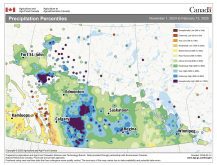The world’s biggest durum producer is set to harvest a good crop.
The European Crop Monitor forecasts an average yield of 53.8 bushels per acre in the European Union, which would be 4.6 percent above the previous five-year average.
Italy’s crop is looking particularly healthy due to a surplus of rain. Yields are projected to be 7.3 percent higher than average in the EU’s largest durum-producing country.
There is also a good durum crop being harvested in two of the three big production regions of North Africa, according to the crop monitor.
Read Also

Why feds imposed EV tariffs
Moe and Kinew have a fight on their hands when it comes to eliminating the EV tariff. Canada has to worry about pissing off the U.S. and Mexico and hundreds of thousands of auto workers.
The average yield in Algeria is forecast at 29 bu. per acre, which is 18 percent above the previous five-year average. Tunisia is pegged at 31 bu. per acre, 16 percent above average.
Morocco is the exception. Average yield in that country is estimated at 23 bu. per acre, which is 16 percent below average.
Jim Peterson, policy and marketing director with the North Dakota Wheat Commission, said big crops in the EU and North Africa do not bode well for North American export prospects, but it isn’t the only demand factor.
“There is still the quality card,” he said.
“We’ve got our fingers crossed that hopefully the EU or North Africa runs into some kind of quality issues.”
Sometimes when countries like Algeria have big yields they also experience problems with protein or vitreous kernels.
Canada and the United States are going to need strong export demand because both countries are expected to have huge carryout supplies heading into the new crop year.
Cam Dahl, president of Cereals Canada, is more focused on the 20 percent decline in seeded acres in Canada, which is the world’s top durum exporter, than he is on the crops in the EU or North Africa.
“That reduction in supply is likely going to have a larger impact than the increases that we see,” said Dahl.
The problem is supply isn’t going to fall nearly as much as acres due to 1.7 million tonnes of carryout, according to Agriculture Canada.
It forecasts 6.87 million tonnes of supply in 2019-20, down 4.5 percent from the previous year.
Durum acres are also down in the U.S., where farmers planted 1.42 million acres, a 31 percent decline from the previous year.
But again, supplies won’t be down that much due to a projected 1.66 million tonne carryout, which is more than double the previous five-year average.
“We may be closer to steady on supplies,” said Peterson.
The U.S. crop is off to a rough start due to dry conditions in North Dakota and northeast Montana.
“We’ve got some that is heading out already,” he said.
Peterson said U.S. durum prices have gone up 30 to 40 cents per bushel in response to the acreage decline but they are still lackluster compared to spring wheat prices.
“So far, the durum market has been immune from what is driving the other wheat markets and the corn market,” he said.
Dahl agreed quality will play a big role in overseas demand for North American durum.
Italy used to be Canada’s top durum customer but sales have tumbled in the wake of country-of-origin-labelling (COOL) on pasta combined with unsubstantiated claims of excessive glyphosate residue on imported Canadian durum.
Some Canadian durum is still making its way to Italy. Bulk exports were 361,100 tonnes through the first nine months of the 2018-19 crop year, making it Canada’s fourth largest buyer behind Algeria, Morocco and the U.S.
In some years before the COOL legislation, Italy bought almost three times that amount over the same nine-month period.
“We are shipping some to them right now but really we have become one of the suppliers of, perhaps not last resort, but pretty close to last resort,” said Dahl.















